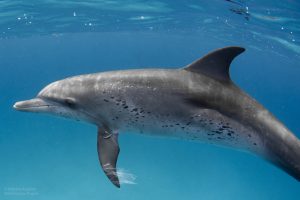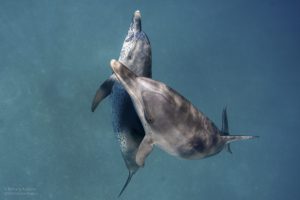
Atlantic spotted dolphins plays with plastic in the Bahamas. Photo: Wild Dolphin Project
Why Plastic Is a Problem
Most plastics are made from fossil fuels and are designed to be durable — meaning they don’t biodegrade in any meaningful time frame. Instead, they break down into smaller and smaller pieces, called microplastics. These particles are now found in nearly every environment on Earth: deep-sea sediments, Arctic snow, and the air we breathe.
In the ocean, plastics can harm wildlife in two major ways:
-
Entanglement — Items like fishing line, six-pack rings, and straps can ensnare dolphins, sea turtles, and seabirds, often leading to injury or death.
-
Ingestion — Marine animals may mistake plastic for food. Once eaten, it can block digestive tracts, reduce feeding, or introduce toxic chemicals into the body.
Humans aren’t immune, either. Microplastics have been detected in seafood, drinking water, and even the human bloodstream. Research is still unfolding, but scientists are concerned about the potential for these particles — and the chemicals they carry — to impact health.
Five Easy Ways to Cut Back on Plastic
Living 100% plastic-free is nearly impossible in today’s world, but we can all reduce our footprint with realistic changes. Here are five easy ones:
1. Bring Your Own Reusables
Keep a reusable water bottle, coffee cup, and shopping bags handy. This cuts down on single-use bottles, cups, and bags — some of the most common items found in beach cleanups.
2. Skip the Plastic Straw (and Utensils)
If you don’t need a straw, just say no. If you do, try a stainless steel, bamboo, or silicone version. The same goes for takeout utensils — let restaurants know you don’t need them.
3. Choose Products with Minimal Packaging
At the store, opt for items sold in bulk or packaged in paper, glass, or metal, which are easier to recycle and less likely to pollute oceans. Farmers’ markets are great for this.
4. Rethink Your Wardrobe
Many clothes are made from synthetic fibers like polyester, nylon, or acrylic — all forms of plastic. These shed microplastics every time they’re washed. Look for natural fibers such as organic cotton, hemp, or wool.
5. Support Plastic-Smart Businesses
From grocery stores offering refill stations to companies using compostable packaging, your purchases can help drive demand for sustainable options.
It’s easy to feel like these steps don’t matter. However, a recent University of Delaware and Columbia University study found that U.S. plastic bag bans and fees cut plastic bag litter in shoreline cleanups by 25–47%, with reductions growing over time and no rebound in usage. Policy and small changes CAN make a difference!

Dolphins play with plastic in the Bahamas. Photo: Wild Dolphin Project.
Why This Matters for Dolphins
At the Wild Dolphin Project, our research focuses on Atlantic spotted and bottlenose dolphins in the waters of the Bahamas. These dolphins live in a marine ecosystem where plastic pollution is becoming more common. Floating debris can tangle around fins, and we’ve even taken plastic away from juveniles using it as a toy! Microplastics have been found in the prey species dolphins rely on. By reducing plastic use, we’re protecting not only dolphins but also the health of the entire ocean food web.
Plastic pollution is a human problem — which means it’s also a human solution. Whether you’re at the beach, in the grocery store, or at home doing laundry, your choices make a difference. Small, easy swaps in daily life can ripple outward, helping to keep our oceans healthier for dolphins, sea turtles, seabirds, and ultimately, ourselves.
